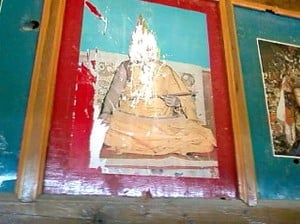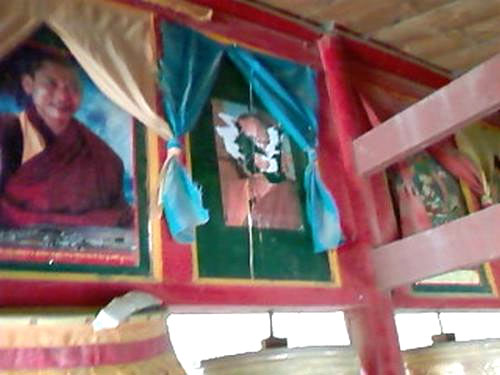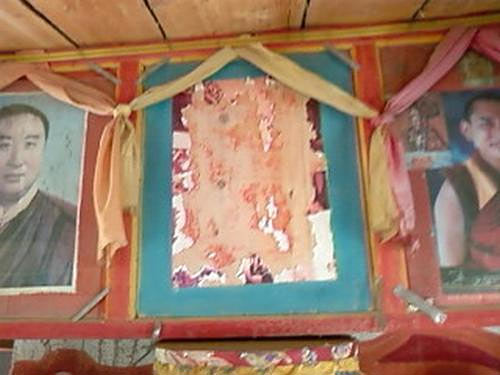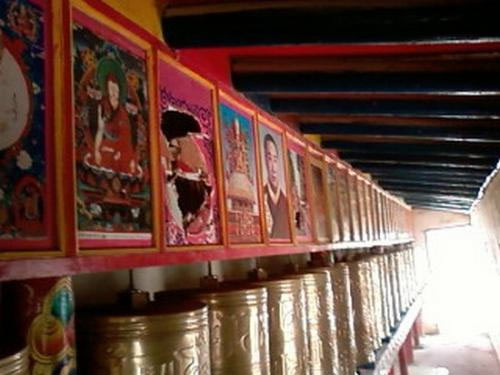
Photo of the 14th Dalai Lama at Kirti Monastery in Ngaba County, Ngaba TAP, Sichuan Province, destroyed by government authorities following a raid on the monastery in early April 2008. Kirti Monastery was at the center of the wave of protests in eastern Tibet when monks were joined by laypeople and schoolchildren in a major protest on March 16, calling for a free Tibet, with pictures of the Dalai Lama and Tibetan flags on display.
Further news has emerged of recent protests in areas including Meldrogungkar (Chinese: Mozhu Gongka) in Lhasa Municipality on April 12, where monks from Pangsa monastery were joined by other monks and nuns and laypeople in calling for an end to detentions and killings, and in Kardze (Chinese: Ganzi) county in Kardze Tibetan Autonomous Prefecture (TAP) in Sichuan, where two nuns in their early thirties held a protest at the county market on April 23, scattering small pieces of paper with messages including “Long live the Dalai Lama”.
Reports of a protest on April 21 at a monastery in Kham, in Serthar (Chinese: Seda) county, Kardze TAP, involving monks and laypeople and suppressed by armed police, could not immediately be confirmed. At the Larung Gar religious institute in the same county, there are serious concerns of possible unrest as officials are attempting to enforce the raising of the Chinese flag, according to two Tibetan sources.
New images have been received by ICT of images of the Dalai Lama and important religious teachers that have been torn or shrines that have been smashed at Kirti monastery, Ngaba (Chinese: Aba) TAP in Sichuan province (published below). Kirti Monastery was at the center of the wave of protests in eastern Tibet when monks were joined by laypeople and schoolchildren in a major protest on March 16, calling for a free Tibet, with pictures of the Dalai Lama and Tibetan flags on display. Reprisals continue at Kirti as the Chinese authorities recently closed the Taktsang Lhamo Kirti Monastic School, affiliated with the monastery, according to reliable Tibetan sources.
A Tibetan from Lhasa who is now in exile and who requested not to be named told ICT: “The level of unrest and continued dissent shows that these hardline policies by China in Tibet have achieved the opposite of what they were aiming for – they have united Tibetans across the plateau in their loyalty to the Dalai Lama and in preserving the integrity of their cultural identity. This has not happened before in two centuries of Tibetan history. The question now is how the Tibetans will take this forward and how it will play out politically.”
Enforced condemnation of ‘Dalai clique’ leads to despair, suicides, detentions
A round of “Cultural Revolution-like political campaigns” are being carried out all over Tibet, according to reports from different areas across the plateau. Work teams have been dispatched to monasteries and nunneries, and within the lay community, meetings convened to condemn the “Dalai clique”.
Reports have been received from various monasteries of distress due to pictures of the Dalai Lama being trampled by armed police or work teams, for instance at Shi-Tsang Gatsel monastery in Luchu (Chinese: Luqu) county, Kanlho (Chinese: Gannan) TAP in Gansu province. According to the Tibetan government in exile, armed police raided the monastery and detained around 28 monks. The monastery was raided again in the early hours of the following morning and another four monks were taken into custody. The Tibetan government in exile reported that armed forces also trampled on images of the Dalai Lama at Choephel Tashi Chokor-Ling monastery in Dukhor town, Chone (Chinese: Zhuoni) county in Kanlho TAP, and where a number of monks had been detained.
A renewed ‘patriotic education’ campaign was formally begun in Lhasa last week, to last two months, with the theme of ‘Opposing Separatism, Safeguarding Stability and Promoting Development’, according to the official newspaper Tibet Daily. The campaign appears to be aimed specifically at the lay community, as rigorous patriotic education is already ongoing in the main Lhasa monasteries. Tibetans are being required by the campaign to denounce the Dalai Lama, with the aim of “deepening the anti-separatist struggle and counter-attacking the Dalai clique’s scheme to split [the country]” (Tibet Daily, April 21). The report in Tibet Daily stated that “performance” in the campaign will be used as a means of “assessing the achievements of Party members and cadres”. There is evidence that since the protests began on March 10, there has been intensified distrust of Tibetan Party members and cadres.
A Tibetan source in Lhasa told a contact: “At the schools and in the offices people have to write stories about the 14th of March and they have to speak ill of His Holiness the Dalai Lama. When they write about the Dalai Lama they are only allowed to write Dalai, otherwise they have to write it again. My child already had to write such stories several times.”
The patriotic education campaign has been extended beyond Lhasa to various counties in the Tibet Autonomous Region (TAR). On April 18, Tibet Daily reported that Sangri County in Lhokha (Chinese: Shannan) Prefecture will carry out a two month long patriotic education campaign among Party members, cadres, retired people, schoolchildren, farmers, herders, and even including the armed police and military stationed in the county. A Tibetan writer and commentator said on a Chinese language blog: “We can say that nobody can escape the campaign. Judging from this, it seems that every township, every county and every prefecture will carry out the political campaign of the same scale, and this will be another ‘Cultural Revolution’ sweeping across the Tibetan areas and touching on the soul of Tibetans.”
A source close to Tibetans in Lhasa told ICT that many monks and nuns have been taken away from monasteries and nunneries in and around Lhasa. The source added that monks and nuns were being taken into custody whether or not they had demonstrated on March 10 or beyond.
At least six monks in Nechung monastery, Lhasa, were detained after apparently expressing their dissent to the patriotic education campaign, according to the Tibetan government in exile. On April 19, a monk reportedly stood up during a patriotic education class and said that the monks did not need these classes, nor did they want to participate, and others joined in (April 23, Tibetan government in exile report, www.tibet.net) According to one further source, there may only be a handful of monks still left at Nechung, a small monastery near Drepung in Lhasa which normally houses around 16 monks.
The same Tibetan source, writing in Chinese on a website, said: “When Tibetans talk about the harsh suppression of the various monasteries, they are all very indignant, but are very scared as well. Since all the monasteries have been forced to close, many Tibetans have to offer butter lamps in front of the carved statues of Buddha on the rocks of Chakpori Mountain [a hill near the Potala Palace with famous engravings of the Buddha], to pray for monks and lay people who were suppressed by the authorities.”
Eight young monks from Nalanda monastery in Lhundrub (Chinese: Linzhou) county in Lhasa Municipality were detained on April 17, according to two reports. A young Tibetan man from Chukha Jang village, Nyima Tenzin, was beaten so severely that he sustained a broken spine, and he was fined 5000 yuan ($713). (April 22, Tibetan government in exile).
In Drango county (Chinese: Luhuo) in Kardze TAP, various sources report a ‘signature campaign’ requiring local people to vilify the Dalai Lama. After he refused to sign, a young farmer from Gephen Li-Khokma village in the county was so severely beaten he had to be hospitalized and his current condition is unknown (Tibetan government in exile report, April 25).
In many areas, Chinese authorities are attempting to enforce the raising of the Chinese flag. At Larung Gar religious institute in Serthar county, Kardze TAP, one of the most important centers for the study and practice of Tibetan Buddhism on the plateau, officials are putting pressure on Tibetan lamas to raise the Chinese flag and participate in political meetings. According to reports received by ICT, the situation at the institute is tense, and local people fear possible consequences of the authorities’ actions.
In Baiyu (Chinese: Payul) county also in Kardze TAP, armed police have told local people that they must fly Chinese flags over the monastery and individual houses. ICT could not confirm whether local people have followed this requirement. According to one report, local officials have told people that if they did not sign their names on a petition condemning the Dalai Lama, they would not allow them to harvest yartsa gunba (caterpillar fungus), an essential source of income for many Tibetans.
Tibetans in Meldrogungkar call for end to detentions and killings: suicides in response to crackdown
A nun in her thirties from Cholung nunnery was so traumatized by the beatings she had witnessed by armed police after a demonstration in Tashigang township, Meldrogungkar in Lhasa Municipality on April 12 that she killed herself, according to reliable reports from Tibetan sources. According to the sources, Tibetan monks from Pangsa monastery were joined by other monks and nuns and local people in a protest, shouting slogans calling for an end to arbitrary detention and the killing of Tibetan protestors, and the release of all political prisoners. They also shouted slogans rejecting official demands that they denounce the Dalai Lama. Armed police broke up the demonstration, apparently using brutal force to beat Tibetans with rifle butts and to break limbs, according to a source. Around 60 Tibetans were detained. According to more recent reports, all of the monasteries in the Meldrogungkar valley area are sealed off by police.
Two nuns who made a bold protest in Kardze TAP in Sichuan have been identified by Radio Free Asia’s Tibetan Service as Bumo Lhaga, 32, and Sonam Dekyi, 30, from the Drakar nunnery in Kardze (RFA, Two Tibetan Buddhist Nuns Detained in Protest – April 27, 2008). RFA reported a source as saying that on April 23, at around 1 pm, the nuns began distributing handwritten flyers calling for the Dalai Lama to return to Tibet and saying that Tibet is independent. Security police began to gather the flyers. The source said: “Later, the nuns were observed on a street-corner shouting slogans calling for the return of the Dalai Lama and for freedom for Tibetans. They were quickly detained and taken away in a police vehicle but even while they were being taken away, they continued to shout.” RFA quoted the mother of one of the nuns, Sonam Dekyi, as saying: “My daughter, Sonam Dekyi, fulfilled her purpose in life. She made her own decision to protest, knowing fully the risk and danger that she would face. I am not worried at all. If she doesn’t survive Chinese torture, I have no regrets… As His Holiness wished, she protested peacefully and didn’t resort to any kind of violence.”
A blind or partially sighted Kirti monk called Tusong, from a village nearby in Ngaba county, Sichuan, committed suicide at the age of 29 on April 16. According to one report, he told his family that just as those with eyes cannot endure what is happening: “even I, a blind person, cannot endure it.”
Officials in the same county, Ngaba, are now required to lead denunciations of the Dalai Lama, and according to one report, these activities will be filmed for propaganda purposes. According to the Tibetan government in exile, many monks and laypeople arrested in the Ngaba area have been taken to detention centers or prisons in Chengdu.
Reprisals at Kirti: closure of school
Reprisals continue at Kirti, where many monks have apparently fled from the monastery, following the March 16 protest. The local government closed the Taktsang Lhamo Kirti Monastic School, affiliated with Kirti monastery in Dzoege (Chinese: Zoige) county in Ngaba TAP in response to students taking part in the protest. Teachers have been left to look for positions in other villages, while students were sent home, according to one source. Some of the children were beaten, according to one report. On March 24 China’s official news agency, Xinhua, reported that most schools in Ngaba county had resumed classes and “life returned to normal after riots earlier this month.” The Dharamsala-based Tibetan Center for Human Rights and Democracy reported that the school was closed on April 8, 2008 (TCHRD, April 17, 2008).
Currently home to approximately 500 students, the school was founded by Dzoge Akhu Nymia in 1986 to teach young monks and children from the surrounding area in the Tibetan language. In 1993, the school was put under the care of Kirti monastery, where the abbot, Alag Lungsang Nangwa Rinpoche, oversaw the completion of the school in 1996. The local government took over official management of the school in 1998, however TCHRD reported that day to day management remained with the monastery until the school’s closing on April 8 (TCHRD, April 17, 2008).
Kirti Monastery was at the center of the wave of protests in eastern Tibet when monks were joined by laypeople and called for a free Tibet on March 16, with pictures of the Dalai Lama and Tibetan flags on display. Exiled Tibetans and other sources reported several hundred arrests in and around Kirti monastery. At least eight Tibetans were killed after police opened fire on the demonstrators, and images of their bodies have been published online (www.freetibet.org and other organizations). Xinhua issued conflicting statements on March 20, first confirming four protestors had been shot dead in Ngaba TAP in Sichuan province, but then issuing a second release reporting that four ‘rioters’ had been wounded. Known among the dead are Lobsang Tashi, a monk from Thawo village, and Tsezen, a layperson from Thachung village.
Laypeople attempt to protect monks during crackdown
In many areas of Tibet in recent weeks, laypeople from all walks of life have joined monks to protest against Chinese policies and in support of the Dalai Lama. On April 4, local Tibetan people gathered to form “a human barricade” near their local monastery, Dring Sumdo monastery in Dzoge county in Ngaba, the same county as Kirti monastery, after armed troops arrived. The Tibetan villagers dispersed when they found out that none of the monks had been detained that day (Tibetan government in exile, April 23).
On the first day of the current wave of protests in Tibet, the most significant uprising in five decades against Chinese rule, local Tibetans in Lhasa formed “a strong, silent, peaceful circle around the police” after a group of Sera monks shouted slogans outside the Jokhang temple on March 10. Tourists, who posted their account on a blog, said that “hundreds” of Tibetans had formed a circle around the police, but that soon the police called for backup and the monks were all detained (ICT report and images, Second day of protests in Lhasa: monks dispersed by tear-gas).
New dissent and detentions in Rebgong
Rongwu monastery in Rebgong (Chinese: Tongren) county, Tsolho (Chinese: Huangnan) TAP, Qinghai, is under lockdown and the whereabouts of monks detained after a protest on April 17 is unclear, according to reports from Tibetans with connections in the area. Armed police raided the monastery and confiscated pictures of the Dalai Lama after monks staged a protest, calling for the release of other monks detained following earlier demonstrations and incidents of dissent in the area in February and March. Monks were seen being taken away from the monastery with their hands tied behind their backs and being loaded onto trucks. Two days later, a number of the monks taken into custody were released after being subject to severe beating in custody, according to sources.
The former head of Rongwu monastery, Alak (an honorific title, meaning ‘lama’) Khaso, a highly respected local figure, had attempted to mediate between the monks and local authorities on April 17, but is believed to have been injured following the police crackdown on the protest. Sources have reported Alak Khaso was taken to hospital in either Lanzhou, Gansu or Xining, Qinghai, but his current whereabouts and condition are unconfirmed. One reliable Tibetan source said that some Tibetan women and an elderly man rushed to try to help the lama after they saw his head bleeding, but were also detained. The same Tibetan source said: “Their hands were tied with wires. At that time they arrested up to 100 people, who filled four military trucks.”
Armed police raided Rongwu monastery, beating monks and taking them into detention, and searching for images of the Dalai Lama. The latest crackdown follows a protest on February 21 after authorities interrupted the annual Monlam ceremony at a local monastery in Rebgong, which was scheduled to end on February 22, and a further incident of dissent by monks on March 17. Radio Free Asia reported approximately 200 protesters, mostly monks, were detained in February after authorities used tear gas to disperse crowds gathered for the religious celebration. It is believed that most of the detained have been released, but many were reported to have suffered injuries. (RFA, Tibetans, Chinese Police Clash at Festival – February 2, 2008).
According to one source, protesters demonstrated at the county seat the next day, demanding that the local government release the monks and lay people who had been taken into custody. The demonstrators were later released; however, three monks and an elderly man suffered injuries after being severely beaten.
There has been a heavy police presence in Rebgong since the February protests. Police forces were reportedly transferred from nearby areas, including Xining, to Rebgong, with one local hotel hanging a banner that read ‘Welcome Special Police from Zhengzhou staying at our hotel’, according to one source.
Despite this repressive atmosphere, a month before the latest protest, on March 17, monks from Rongwu burned incense and shouted slogans of support for the Dalai Lama and Tibetan freedom. They also called for the authorities to let the Dalai Lama return to Tibet, and to “hand back the Panchen Lama and his parents to the Tibetan people.” Gendun Choekyi Nyima, recognized by the Dalai Lama as the 11th Panchen Lama, has been in Chinese custody in an unknown location since 1995. The monks were prevented by armed police from taking the protest further. (ICT report, Protests continue in eastern Tibet).

Photo of the 14th Dalai Lama at Kirti Monastery in Ngaba County, Ngaba TAP, Sichuan Province, destroyed by government authorities following a raid on the monastery in early April 2008. A Tibetan from Lhasa who is now in exile and who requested not to be named told ICT: ‘The level of unrest and continued dissent shows that these hardline policies by China in Tibet have achieved the opposite of what they were aiming for – they have united Tibetans across the plateau in their loyalty to the Dalai Lama and in preserving the integrity of their cultural identity. This has not happened before in two centuries of Tibetan history. The question now is how the Tibetans will take this forward and how it will play out politically.'”

An image of the 14th Dalai Lama, destroyed by government authorities at Kirti monastery in early April. Mass detentions of monks have continued in the past week and more monasteries have been sealed off by armed troops as a rigorous patriotic education campaign across the Tibetan plateau leads to increasing unrest.

A Tibetan source, writing in Chinese on a website, said: ‘When Tibetans talk about the harsh suppression of the various monasteries, they are all very indignant, but are very scared as well. Since all the monasteries have been forced to close, many Tibetans have to offer butter lamps in front of the carved statues of Buddha on the rocks of Chakpori Mountain [a hill near the Potala Palace with famous engravings of the Buddha], to pray for monks and lay people who were suppressed by the authorities.’

Officials in Ngaba County are now required to lead denunciations of the Dalai Lama, and according to one report, these activities will be filmed for propaganda purposes. According to the Tibetan government in exile, many monks and laypeople arrested in the Ngaba area have been taken to detention centers or prisons in Chengdu.

A round of “Cultural Revolution-like political campaigns” are being carried out all over Tibet, according to reports from different areas across the plateau. Work teams have been dispatched to monasteries and nunneries, and within the lay community, meetings convened to condemn the ‘Dalai clique’.

